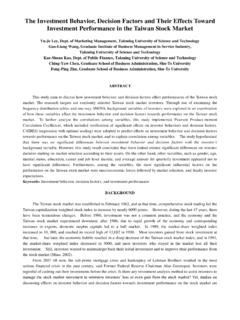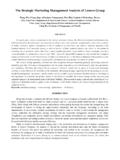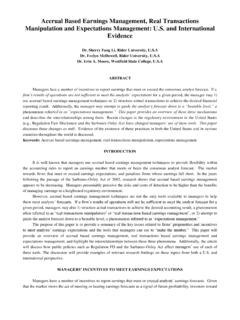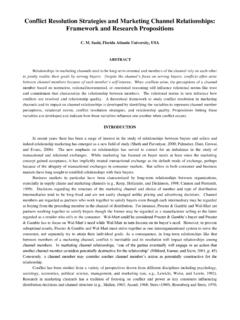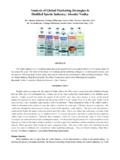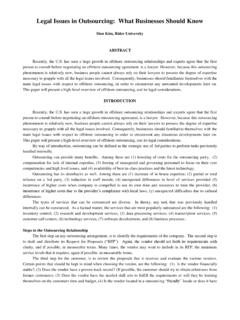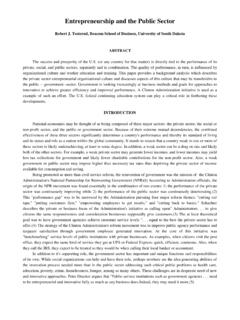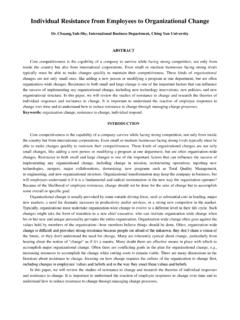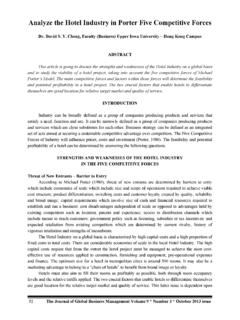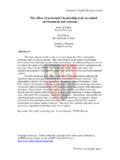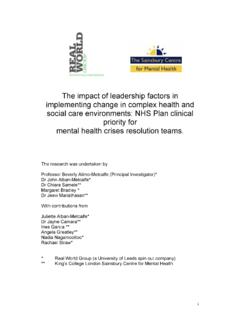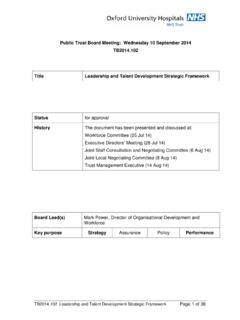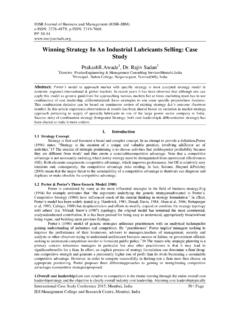Transcription of Distinguishing between leaders and leadership in global ...
1 Distinguishing between leaders and leadership in global Business Dr. Yueh-shian Lee, Assistant Professor, Department of Accounting, Feng Chia University, Taiwan Dr. Weng Kun Liu, Assistant Professor, Department of International Trade, Feng Chia University, Taiwan ABSTRACT Most global business leaders at the President or Chief Executive Officer level in an organization have at least considered their individual leadership styles and abilities to lead subordinates to achieve the organization s goals in the future. It is much rarer to find a company which has considered and then effectively implemented leader and leadership concepts and provided clear guidance on how managers of a firm should act as they do business in the global arena. This paper explains the Distinguishing elements between leaders and leadership . A part of leadership is the close connection between the leader and the follower.
2 leadership is the ability to express a vision, influence others to achieve results, encourage team cooperation. However, leadership must be done by a leader. INTRODUCTION As global business has grown and evolved rapidly, a manager is probably considered a leader, and if a leader is not yet a manager, he or she could eventually become a manager in the future. Undoubtedly, a successful leader creates an opportunities that help the business grow and survive. The literature selected for this research paper, first is to distinguish the leader and leadership . The second purpose is to support the influence of leader and leadership in running global business. The third purpose is to support an understanding of leader and leadership concepts which help ensure success in global business. The broad concept of leadership is a delicate combination of the process of leadership , the person of leader, and the specific job of leadership .
3 Although the concept of leadership can be distinguishable and definable separately from our understanding of what and who leaders are, the phenomenon of leadership can only be known and measured in a particular situation of a leader doing a job. This paper examines the distinctions between the process of leadership , the person of leader, and the task of leadership . This study also examines the effect of leadership on global business in order to help executives from global corporations tailor their behaviors and execute their leadership abilities for their organizations. LITERATURE REVIEW Leader A leader has to implement a personal agenda, and the organizational agenda. The personal agenda consists of the goal close to the leader s heart. The organizational agenda establishes the framework within which all work is done. Employees must know what is to be done, when it is to be done, and their part in making it happen.
4 The good leader must be able to state the agenda in a few sentences that everyone can grasp. Moreover, a leader needs to have a pragmatic and understandable operating philosophy. The framework of an operating philosophy is created from learning, innovating, and deciding. A leader may not recognize the personal characteristics that cause people to follow him or her, but the followers respond to those characteristics (Crosby, 1997). Since the process of leadership cannot be separated from the person as leader, the following traits and talents are required for an individual who will adequately fulfill the role of leader: character, charisma, switching mindsets, and know-how. 1. Character: Sheehy (1990) argued that character is the most crucial and most illusive element of leadership . As applied to human beings, it refers to the enduring marks in our personality which include our inborn talents as well as the learned and acquired traits imposed upon us by life and experience.
5 2. Charisma: The function of a charismatic leader is the vital part of leadership . Charismatic leaders are able to express themselves fully. They also know who they are, what their advantages and disadvantages are, and how to completely use their advantages and compensate for their disadvantages. Moreover, they know what they want, why they want it, and how to communicate what they want in order to gain cooperation and support from others (Bennis, 1989). 3. Switching mindsets: The leaders success in confronting challenges rests entirely on theleaders' ability to change mindsets, create new realities and thereby see new alternatives and possibilities. A mindset is a consistent but unexamined framework of assumptions and viewpoints about the nature of reality as it pertains to business. It is a lens or a filter that controls your mind, your thoughts, your perceptions and your actions.
6 Through switching leaders ' mindsets, leaders could alter the entire range of business actions and solutions available to achieve new success in leadership . 4. Know-how: leadership in different areas requires different technical expertise. Bennis (1989) stated that leaders must possess "business literacy" ( ). That is, leaders must have knowledge of and be experts at what they are doing. leaders must have horizontal and vertical knowledge of how the business works and a full understanding of what is required to do the task well. leadership Crosby (1997, p. 2) said that, leadership is deliberately causing people-driven action in a planned fashion for the purpose of accomplishing the leader s agenda ( ). leadership means that a leader is selecting people carefully and steering them in his direction. leadership is a clear agenda, a personal philosophy, enduring relationships, and worldliness.
7 However, leadership must be done by a leader. leadership is the accomplishment of a goal through the direction of human assistants. The man who successfully marshals his human collaborators to achieve particular ends is a leader (Prentice, 2005, ). Rost (1993) defined leadership as "a power and value laden relationship between leaders and followers who intend real changes that reflect their mutual purposes and goals" (p. 102). All forms of leadership must use power. However, power needs not be coercive, dictatorial or punitive to be affective. Instead, power can also be used in a non-coercive manner to orchestrate, mobilize, direct and guide members of an institution or organization in the pursuit of a goal or series of objectives (Thomas, 2011). Peters and Waterman (1982) stated that "The real role of leadership is to manage the values of an organization" (p.)
8 255). All leadership is value laden. Also, all leadership , whether good or bad, is moral leadership . leadership is a process of influence which involves an ongoing transaction between a leader and followers (Hollander, 1978). leadership , however, does not exclusively reside in the leader. Rather it is a dynamic relationship between leaders and followers alike. leadership is always plural; it always occurs within the context of others. leaders and followers intend real changes. All forms of leadership are essentially about transformation (Rost, 1993). Transformation is about leaders and followers intending to pursue real changes actively. leadership is not about maintaining the status quo; it is about initiating change in an organization instead. The process of leadership always involves a certain number of transactional changes. The important requirement of the leadership process is for leaders to remember the followers to pursuit their mutual purposes and goals.
9 Through education and training, leaders must serve as effective teachers or mentors to make their followers co-responsible in the pursuit of their mutual purposes and goals (Nanus, 1989). leadership is an extension of the leader s beliefs. A highly personal core competence is only from within the leader. In leadership and the customer revolution, Rick Tate (2003) said leadership touches the heart and soul. global Business There are various opinions about the success or failure of global business that should be considered by businesses hiring leaders from various parts of the globe. Varying opinions are detailed in literatures and journals. Stiglitz critiques global business based on the role played by multilateral institutions and their principal shareholders in pressing developing countries to liberalize their economies. Gilpin (2001) argues against globalization and the fall of the nation-state.
10 He asserts that nation-states continue to be the major actor in both domestic and international affairs and have not been displaced by other players such as non-governmental organizations, regional forums, and international federations. Bhagwati (2004) and Gilpin (2001) examined on economic globalization defined as international integration, foreign trade, foreign investment, cross-border migration, and technological diffusion. Although global business may have reduced the main differences between management practices, such as leadership styles, other research shows that management and leadership styles are still highly shaped by culture (Mehta, 2003). It has long been recognized that what is acceptable behavior in one culture may not be acceptable in another culture (Casimir & Li, 2005, p. 275). House (2004) suggested that .. as economic borders come down, cultural borders could go up, thus presenting new challenges and opportunities for business (p.)
